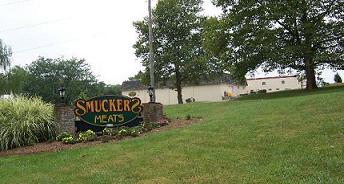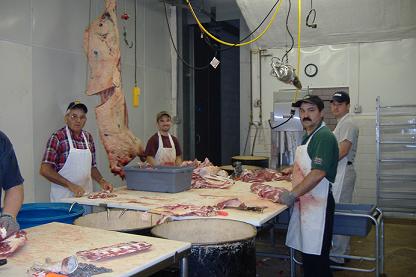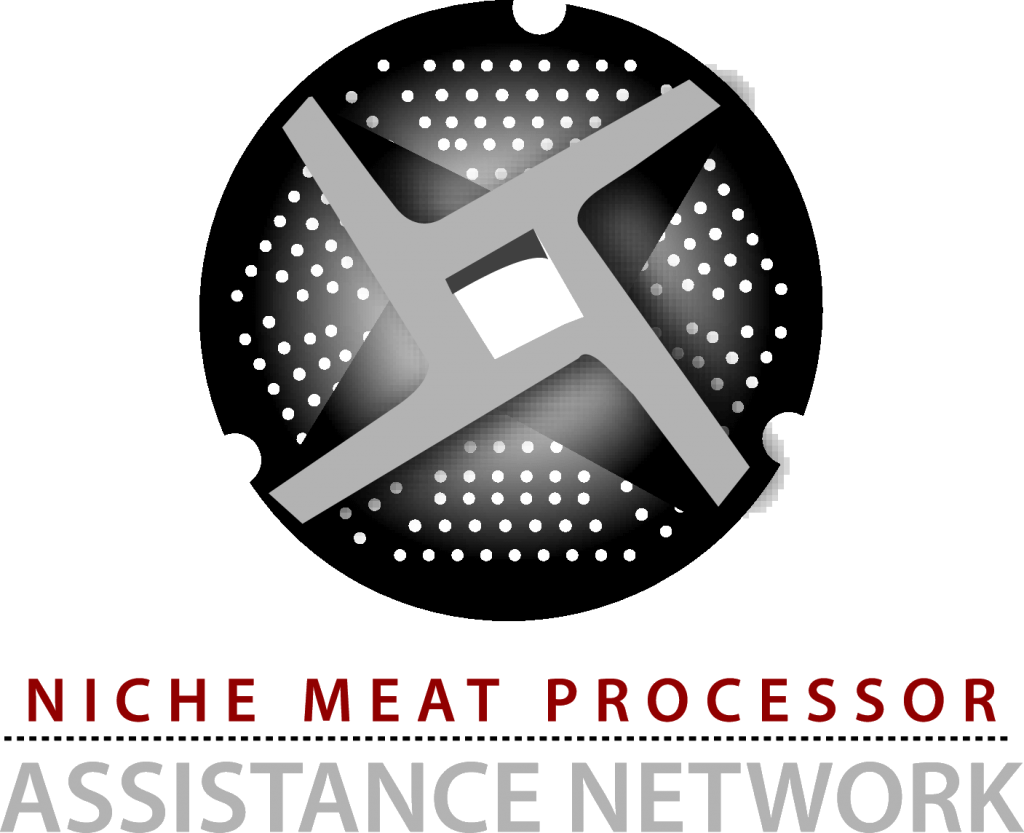Smucker’s Meats is a USDA-inspected slaughter, fabrication, and further-processing plant for red meat. The core of their business is processing locally grown livestock that are sustainably raised. Their services are in high demand — they are typically scheduled out 3-4 months. They are located in Mount Joy, PA.
Basic information
Capacity per week: Average 45 head cattle, 5 bison, 5-10 hogs, occasional sheep & goats
Hours/day of operation: 7am-5pm M-F, 6am-2:30pm under inspection
Weeks/year: 52
Species: beef, bison, hogs, sheep, goats
Services: custom slaughter & processing to case-ready, vacuum-packed, w/customer’s labels, fresh or frozen; jerky, sticks, sweet baloney, ham, bacon, smoked products, sausage, sloppy joe, burger, chili; house brand BBQ
Square feet: 10,000 sf
#/type of employees: 25-30, full-time & part-time
Annual sales revenues: over $1 million and growing
Price of services: beef: $48 for slaughter, 0.55/lb hot weight for cut & wrap. Value-added varies: baloney & BBQ $1-2/lb; jerky/sticks $3-4/lb
Operational costs: Approx. 75% of gross revenue, so ~$750,000/yr. Their biggest cost is labor.
Retail on-site: No.
Wholesale: Yes, but only 8-9% (2000 lbs/wk of their BBQ)
Inspection: USDA inspected
Certified organic: No. Have considered but are already booked solid without it.
Certification agency: n/a
Custom work: Yes
Source verification on label: Yes, but few customers request it; aren’t large enough to need it.
Basic history/development
Smucker’s Meats is a family operation, run by Jay Smucker with his sons, Mike and Jason. The family got into meat processing in 1965, when Jay’s father, Dave, started a butcher business in nearby Manheim, PA. Jay bought in as a partner, and Mike and Jason grew up in the business. In the mid-1990s, Jay bought Dave out. It was a custom shop, no inspection, with a retail store; they also sold at farmers markets. They processed 200-300 head/year, from ’85-’03.
In 2003, a fire destroyed the building. Jay hadn’t owned the property, only the business, so he had to start from scratch financially (see below, under “funding sources”). He bought an existing USDA-inspected butcher shop in Mount Joy. It was 25 years old and had to be completely renovated: ceilings, floors, roof, drains, and more.
Initially, Smucker’s had USDA inspection only to process their own BBQ products; they also did uninspected, custom slaughter and processing. In 2005, a Maryland meat company raising all-natural (no hormones or antibiotics) Black Angus beef, and expanding their business, offered to finance the required upgrades if Smucker’s would become entirely USDA inspected. Smucker’s agreed.
As soon as their kill floor came under USDA inspection, it was in high demand, because demand for local, sustainably-grown food was steadily growing in their region. In 2006, they had only 6 employees, including Jay, Mike and Jason. Today, they have 25 to 30, full time and part time.
Funding sources
After the fire, they financed renovations and business start-up at the Mount Joy shop with a conventional bank loan. Though they were long-time customers, the bank wouldn’t loan them all they needed, so Jay’s father, Dave Smucker, financed the rest. They have recently re-financed with another bank loan from a different bank. They have only recently begun learning about possible grants or low-interest loans that might be available to a business like theirs.
Business plan
Jay Smucker ran the Manheim business the way his father had, without a business plan. For the new business in Mount Joy, says Mike, “we weren’t just starting over financially but also in the sense of how we did business. We wrote a business plan. We set goals.” In 2007, Jay, Mike, and Jason formed an LLC to start the process of generational transition. After the fire, Jay had said he wouldn’t start again if his sons weren’t interested. Fortunately, they were: “we thoroughly enjoy what we do,” says Mike.
With help from SCORE, they did most of their own business planning. At first, the plan focused on the BBQ products and deer season. They soon realized that such a seasonal business couldn’t support a plant and investment of that size: they had to be year-round. That was why USDA inspection made sense.
In 2006, they refinanced with another bank and completely re-wrote their business plan, which now focuses on USDA-inspected processing for local, sustainable livestock markets.
They don’t have specific requirements that animals they process must meet. Most are good market steers, from a range of feeding programs & labels, including quite a few all-natural (no hormones/antibiotics) and grass-fed. Some are organic but don’t need organic certified processing. Some are commodity, grain-fed beef for local sales of halves or quarters (freezer meat) or occasional cull cows from a few small-scale dairies, to make baloney & other value-added products.
Smucker’s has learned that certifications and labels only go so far. For most of their customers, Mike says, “if they are talking to the people buying their meat, they’re a better advertising tool than what’s on the label.” Smucker’s encourages farmers to tell their stories to their customers, to build relationships.
Smucker’s applies this principle to its own business: two years ago, Jay spent a day or two every week visiting their farmer customers, learning about their farms, and feeding programs, how they raised their animals. By getting a better sense of what the farmers were doing, the butchers could work with them better. Mike says, “We’ve found that those customers we’ve visited have been the best and most loyal.” He hopes to restart these visits once they are less short-staffed.
Pricing: they’ve raised their prices a couple of times over the last two years, as they’ve come to understand their costs and margins better (especially for value-added; it’s harder to know for custom processing and packaging). In January 2008, they raised prices 25%. At the time, they were scheduled 6 months out, but no one called to cancel.
The business continues to evolve. As of 2010, Smucker’s discontinued deer processing entirely, due to increased inspected processing. They are also in discussion with USDA to increase capacity for hogs, sheep, and goats by adding an additional inspection day.
Deciphering regulations and complying
It took longer than they expected to get their grant of inspection. Mike took a HACCP training course at Penn State, but they hired a consultant to write their first HACCP plan. At the same time, they wrote to USDA to start the process of becoming inspected and were assigned an inspection number (held for one year, after which they’d have to write another letter to start over).
Then a long cycle of facility inspections began: a USDA inspector would come out and find things that needed to be improved before a supervisor would come out. After those improvements were made, the inspector would come again and find still more necessary improvements. The inspector appeared to have a list of requirements, that the Smuckers never got to see, and at times the inspectors seemed to be finding small things wrong just to stall the process, or that the next agency person in charge of the process didn’t have all the information to move it forward.
After several cycles of this, USDA finally, and it seemed reluctantly, scheduled a supervisor to come out. That visit generated yet another list of necessary changes – but this time, after those changes were made, the supervisor sent through the application that would give the Smuckers their temporary grant of inspection. Even then, Jay Smucker had to drive to the district office in Philadelphia to get the district manager to sign that grant of inspection. When they started the process, they’d only planned on the plant being down for about a month – it took three, and happened “only after we made ourselves a pain to them.”
However, though the process was slow and difficult, they now work well with their inspectors, who usually help to find solutions for issues as they arise.
From the start, the Smuckers have received substantial guidance and support from the American Association of Meat Processors (AAMP). AAMP’s Executive Director, Jay Wenther, is a neighbor in Mount Joy and has provided extensive advice and education. For example, he reviewed their early HACCP plan and wrote them another, which Mike used to overhaul their whole HACCP program. He continues to rely on AAMP for regulatory advice.
Apart from USDA, no other state or local permits were required because the facility was already a butcher shop before the Smuckers bought it.
Plant design
The design was decided to some degree by the existing building, e.g. location of the kill floor and the coolers. They designed the rest of it themselves.
In 2010, they made a number of capital improvements, for the first time using available capital rather than having to borrow or extend their line of credit. Improvements include both a rebuilt smokehouse and a stuffer, which will allow them to develop a line of hotdogs, something their customers have been requesting for a few years. The livestock holding pens are also being upgraded, which should be complete in 2011.
As capacity increases, so has the need to find more efficiencies. They aim to upgrade the slaughter floor to increase production and at the same time also improve quality and food safety.
Big Glitches and how they were solved
When they’ve made changes to improve operations, they haven’t asked for enough money (i.e. a large enough loan), and then they have to play catch up, by increasing prices or looking for more funding. Every day some piece of equipment breaks down, especially refrigeration in the summer. But they have enough coolers and freezers that if one fails, it’s inconvenient but not a disaster.
Required equipment
Almost all the equipment from the Manheim shop was salvageable after the fire. Since then, they have bought some equipment, mostly used, though last summer they invested in a new roll stock machine, to replace an old, rebuilt one that no one knew how to fix. Although the new machine cost about $100,000 they feel it was well worth the investment. In particular, the machine sets a reasonable and consistent pace in the packaging area that keeps productivity high. “When they’re back there and the machine is going, I know things are getting done.”
Staff needed and how they were found/trained, what they cost
They average 25-30 staff, full-time and part-time, with more to be added in the busy fall season. The cutting department has about 9 or 10, packaging has about 7 or 8, and further processing about 5 or 6, with the rest in support roles like maintenance, administration, and sanitation.
Wages begin at $8/hr for someone with no experience and rise to about $14/hr for experienced employees. All FT employees get health insurance and paid vacations and holidays.
Finding enough trained staff was originally a struggle. They planned to hire experienced people, especially for cutting. Yet experience often meant cutting boxed beef in supermarkets, which is very different from breaking whole carcasses. “You’re dealing with trained labor that someone else trained,” Mike says. “So you have to untrain & retrain.” Training someone with no experience takes longer, but then that person is properly trained for the job.
“But now that a majority of our crew is reaching 3 or more years with us, we are finding we are more efficient,” he says. “Adding new people into the mix is not as difficult because those with experience can carry the weight – and help with training – while the new person learns.”
They originally found staff by advertising in the local paper but more recently have not need to advertise, as most applicants come through word of mouth from existing personnel. The recession has meant more applicants, and they typically have a list to pull from as jobs open up or are created. They’ve had some bad hires in the past but now have a very good crew.
As the company has grown over the past few years, so has the number of meetings with staff and management. At a weekly 15 minute meeting with the entire staff, managers share successes as well as areas for improvement and other issues. At a 30 minute weekly meeting, department supervisors discuss weekly concerns and production goals. The four members of the LLC (Jay, Marty, Mike, and Jason) also meet weekly to review financials, develop strategy, and determine vision and direction.
“We have found that all of these meetings are vitally important psychologically,” Mike says. “They directly affect production efficiency and act as a sort of anchor to keep everyone tied to our goals and vision.”
Financial sustainability plan
In 2010, they were finally able to finance capital improvements without taking on new debt or extending their line of credit. This success indicates that the company is well on its way to financial sustainability.
Growth to date
They have 100-200 regular clients. The only way to increase production is bricks and mortar. They can do more value-added products and further processing, but they’re at full capacity for slaughter.




